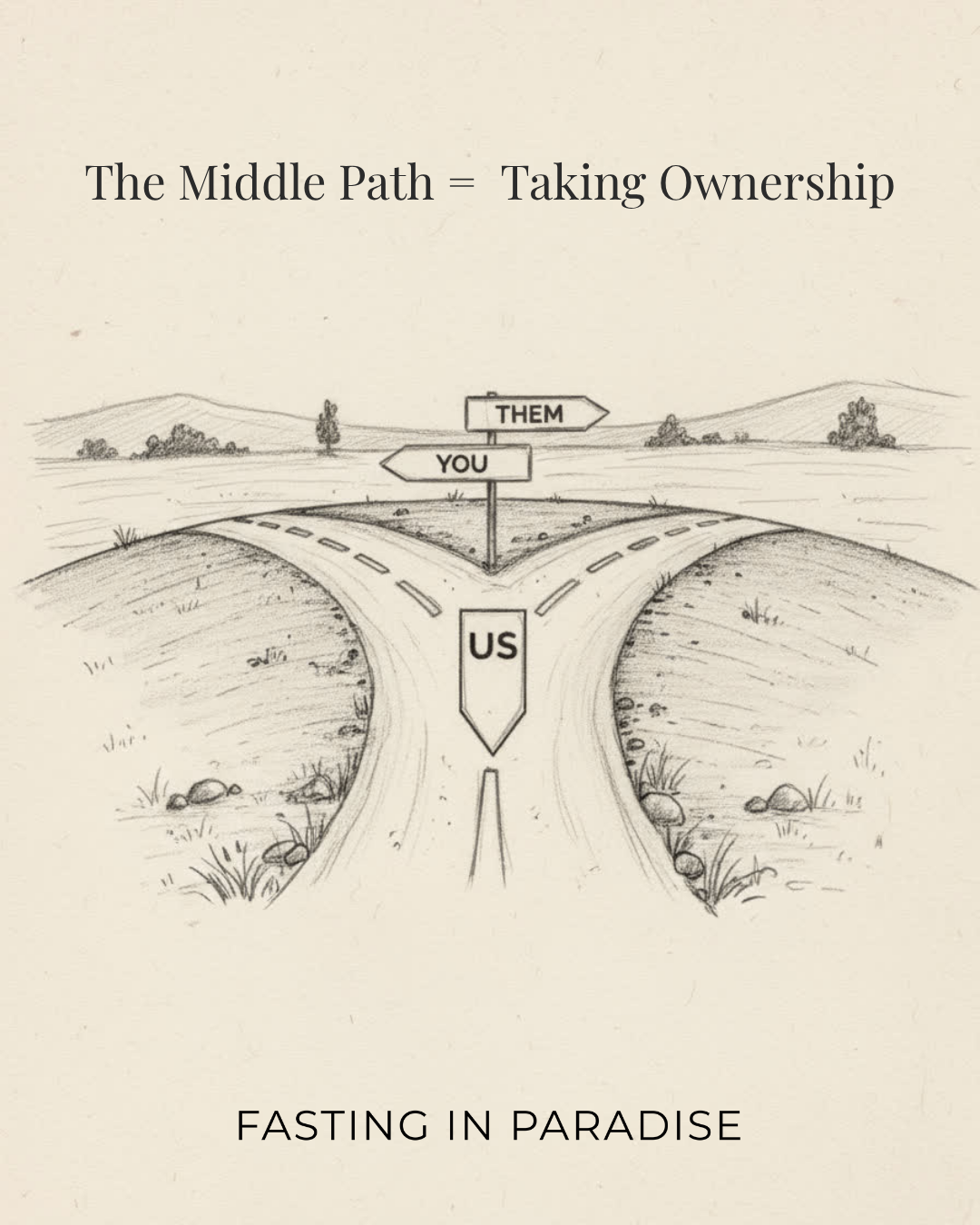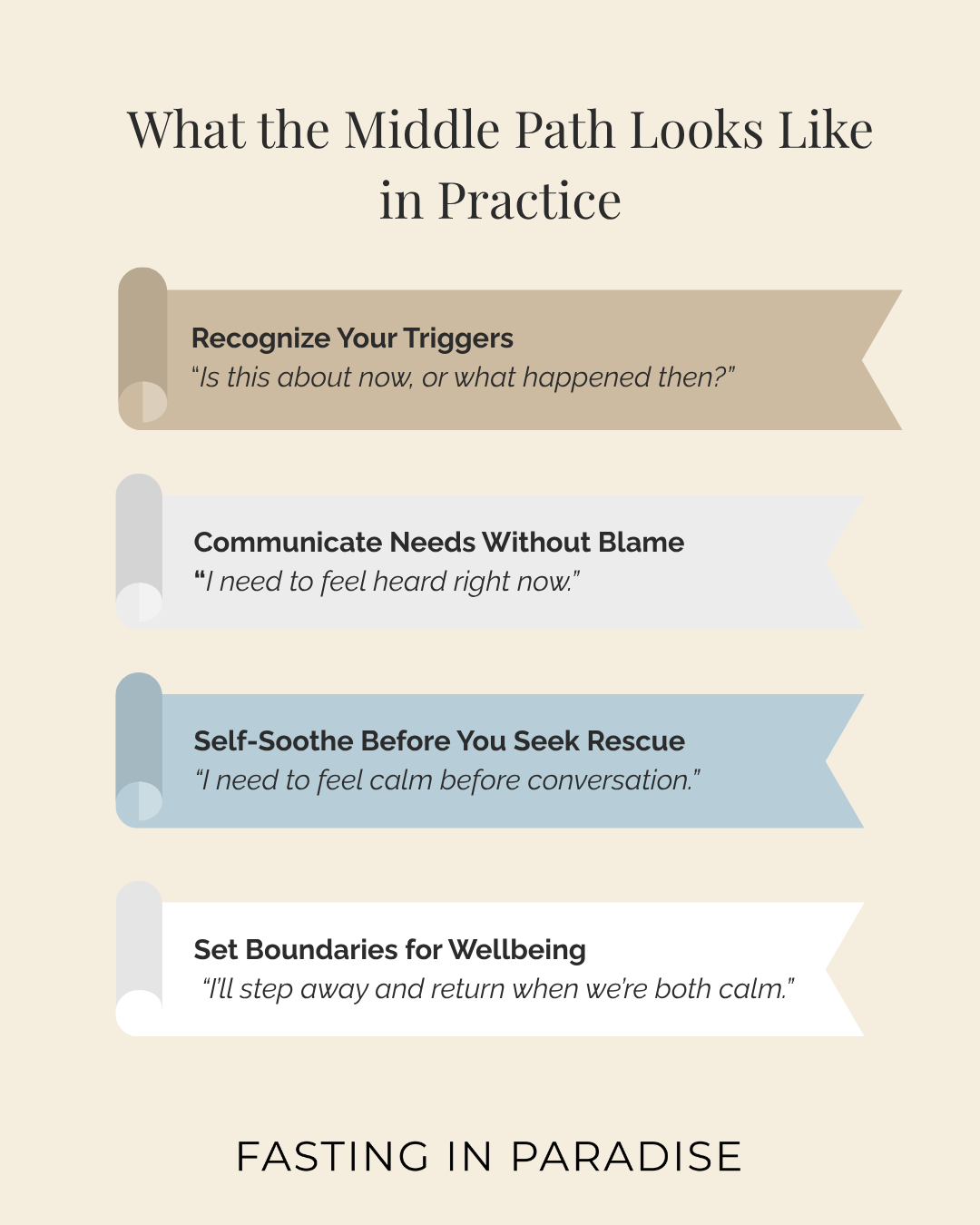Healing Individual Wounds Within Marriage: The Middle Path
We're drawn to partners whose wounds complement our own in strangely perfect ways.
As my husband and I approach our 11th anniversary this December, I've been reflecting on what makes relationships truly work—and why I'm sharing something different today. While my content typically focuses on fasting and physical wellness, mental and emotional health is the foundation that makes everything else possible. At Fasting in Paradise, we understand that true wellness isn't just about ketosis or building biology; it's about the relationships and emotional patterns that directly regulate our nervous system.
Your nervous system is your body's internal leadership—it determines whether you're in a state of repair and renewal or constant fight-or-flight. When relationship stress keeps triggering survival mode, cortisol stays elevated, digestion suffers, sleep becomes elusive, and every other body system begins to break down. You simply cannot heal in a state of chronic nervous system activation.
This reflection on marriage and personal responsibility might seem off-topic, but it's actually central to the wellness journey. The stress of unresolved relationship patterns keeps your nervous system locked in hypervigilance, undermining every wellness protocol you follow—no matter how perfect your fasting window or how clean your environment.
So as we approach this milestone, I'm sharing what I've learned about the intersection of personal growth and partnership—because learning to regulate your nervous system within your primary relationship might be the most important wellness practice of all.
Most couples therapy eventually becomes an excavation of childhood wounds.
One partner's fear of abandonment collides with another's need for space. Someone's drive to control meets their spouse's resistance to being managed. What looks like relationship conflict is often two people's survival strategies from childhood playing out in adult love.
The Unconscious Draw
My husband and I
We're drawn to partners whose wounds complement our own in strangely perfect ways. The person who learned to repeat themselves to be heard pairs with someone who shuts down when they feel pressured. The people-pleaser finds the emotionally unavailable partner. These aren't coincidences—they're our psyches seeking familiar dynamics with the unconscious hope of finally getting them right.
My husband and I have been together for 11 years, married for 2, and we've learned that recognizing these patterns doesn't require excavating every childhood hurt. While our adult patterns and beliefs are largely shaped from birth to age 7, we don't need to spend years in therapy dissecting each wound. What matters is developing a fundamental understanding of how our subconscious beliefs formed, so we can see them with adult eyes and question their validity in our current life.
The Two Extremes That Don't Work
When couples recognize these patterns, they typically swing toward one of two extremes:
Complete Enmeshment: "Your feelings are my responsibility, and my feelings are yours." Partners become emotional managers for each other, trying to heal each other's childhood pain through perfect attunement and care. This creates codependency and resentment.
Complete Independence: "Your triggers are your problem; my triggers are mine." Partners emotionally disconnect, avoiding any behavior that might activate the other's wounds. This creates parallel lives and emotional isolation.
Neither extreme allows for real intimacy or growth.
The Middle Path: Taking Ownership Together
The healthiest approach requires walking a tightrope between these extremes. It involves taking full responsibility for your own emotional patterns while maintaining reasonable expectations for how your partner shows up in the relationship.
This is the foundation of what's worked in my own marriage. We're not perfect—we have our ups and downs—but our commitment to taking ownership of how we show up has been transformative. We self-reflect, we communicate with respect for each other's needs, and most importantly, we don't make each other responsible for fixing wounds we developed before we even met.
Owning your own patterns is the only path that leads to genuine togetherness.
I truly believe this is the defining moment for any relationship at a crossroads. When you're standing at that fork in the road—divorce or deeper commitment, breakup or breakthrough—this middle path of taking ownership is THE path forward. There's no other way through. You either both commit to owning your patterns while staying engaged with each other, or the relationship will keep cycling through the same painful dynamics until it breaks. This isn't one option among many; when a relationship is in crisis, this is the only path that leads to genuine togetherness rather than just postponing the inevitable.
This looks like:
Recognizing your triggers as information about your own unhealed places, not evidence of your partner's failures. When you feel the familiar surge of an old wound being activated, you pause and ask: 'Is this about what's happening now, or what happened then?' You don't need to analyze every detail of your childhood—just notice the pattern, understand it came from a younger version of you trying to stay safe, and choose a different response with your adult wisdom.
Communicating your needs without demanding that your partner heal your childhood pain. Instead of "You never listen to me" (which makes your partner responsible for your childhood experiences of being dismissed), you might say "I have a strong need to feel heard right now."
Learning to soothe your own nervous system when old wounds get activated, rather than immediately making it your partner's job to fix your emotional state.
Setting boundaries based on your own wellbeing rather than trying to control your partner's behavior. Instead of "Don't shut down on me," you might say "I'm going to step away when you're not available for conversation and try again later."
The Middle Path—walked together by both partners— is the only way to growth in a relationship
The Crucial Caveat
This framework only works when both people are genuinely committed to their own growth. When one person does all the self-reflection while the other continues harmful patterns under the guise of "that's just my childhood trauma," it becomes a setup for emotional enabling.
The self-aware partner can become trapped in endless self-examination: "Maybe if I just work on my abandonment issues, I won't be triggered by their emotional unavailability." But some partner behaviors are legitimately problematic, regardless of your childhood history.
Both/And Instead of Either/Or
The real work happens in the space between taking responsibility for your own wounds and having appropriate expectations for your relationship.
Healthy relationships require holding two truths simultaneously:
Your emotional reactions are your responsibility to understand and manage
Your partner's behavior genuinely affects you and you can have reasonable expectations about how they treat you
You can work on your pattern of repeating yourself when you feel unheard AND expect your partner to engage with your concerns respectfully. You can recognize that your need for control stems from childhood fear of loss AND ask your partner to be reliable and communicative.
The Growth Edge
The real work happens in the space between taking responsibility for your own wounds and having appropriate expectations for your relationship. It's messy, requires constant recalibration, and demands the kind of emotional maturity that most of us are still developing well into adulthood.
The beauty is that healing happens through practicing new communication tools and healthier patterns, not through endlessly analyzing the past.
The beauty is that healing happens through practicing new communication tools and healthier patterns, not through endlessly analyzing the past. Each time you choose personal responsibility over blame, each moment you communicate your needs with clarity rather than criticism, you're literally rewiring those old beliefs formed in childhood. The relationship becomes your laboratory for growth—not because you're dissecting old wounds together, but because you're creating new, healthier patterns that gradually replace the old ones.
But when both people commit to this balance—healing their own patterns while staying engaged with each other's growth—something remarkable happens. The relationship becomes a container for transformation rather than just a stage for reenacting old trauma.
This is where my husband and I find ourselves now. It could have easily gone the other way—there were moments at that crossroads where we could have chosen the familiar path of blame and disconnection. We still get triggered; we still have moments where old patterns flare up. But our commitment to this approach of taking ownership has already strengthened our marriage in ways I couldn't have imagined.
The wounds that drew you together can become the very places where you learn to love more skillfully, both yourself and each other. We're living proof that when you choose this middle path, even imperfectly, even with setbacks, the relationship transforms from a source of stress into a sanctuary for growth.
Special thanks to Heidi Hostetler at Sun Valley Family Therapy, whose skillful guidance in The Gottman Method helped us discover this middle path. The tools and insights we gained through our work together have been transformative for our marriage.
© 2025 Fasting in Paradise, LLC. All rights reserved. This content is proprietary and confidential. Reproduction, distribution, or copying of any portion without express written permission is strictly prohibited.






